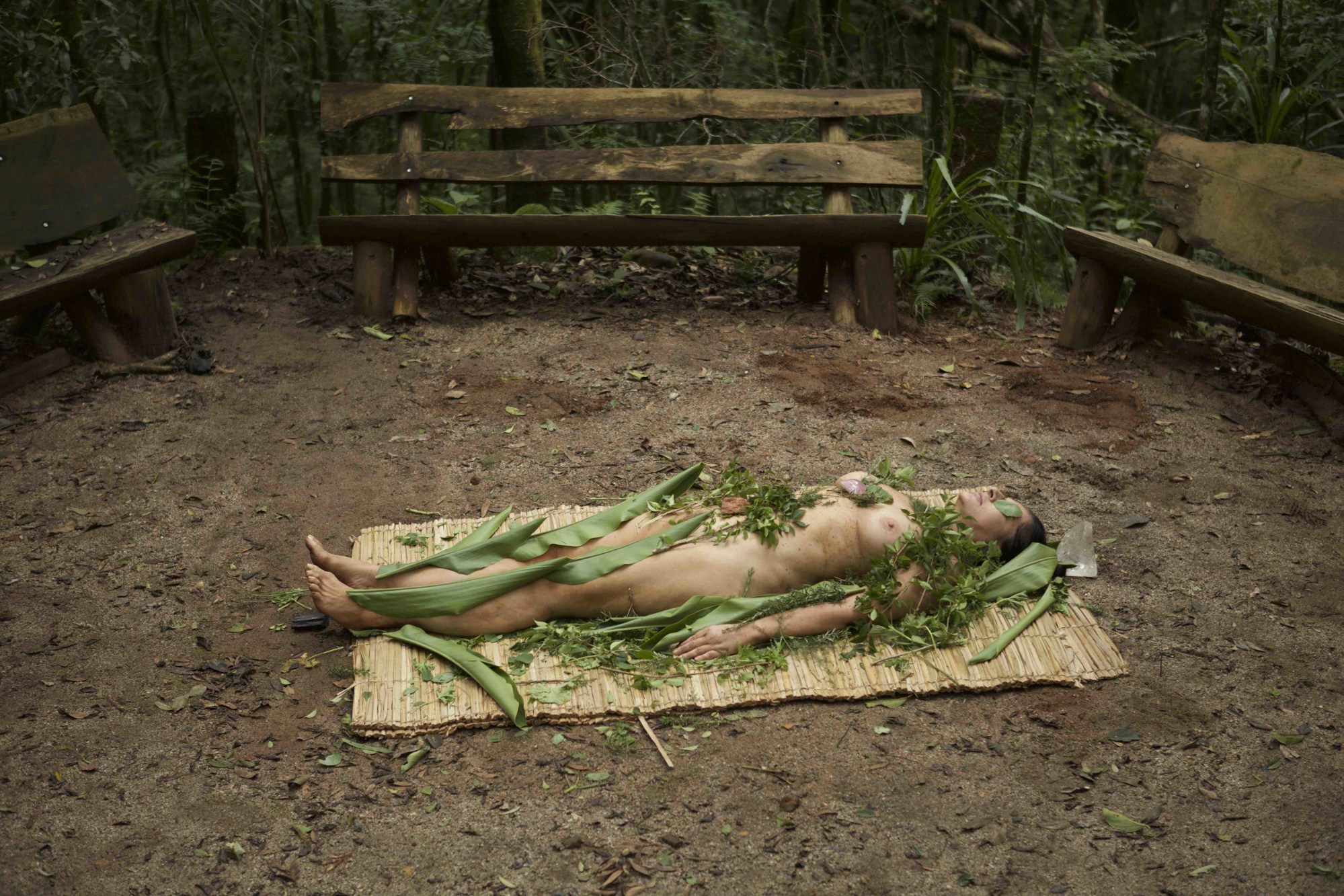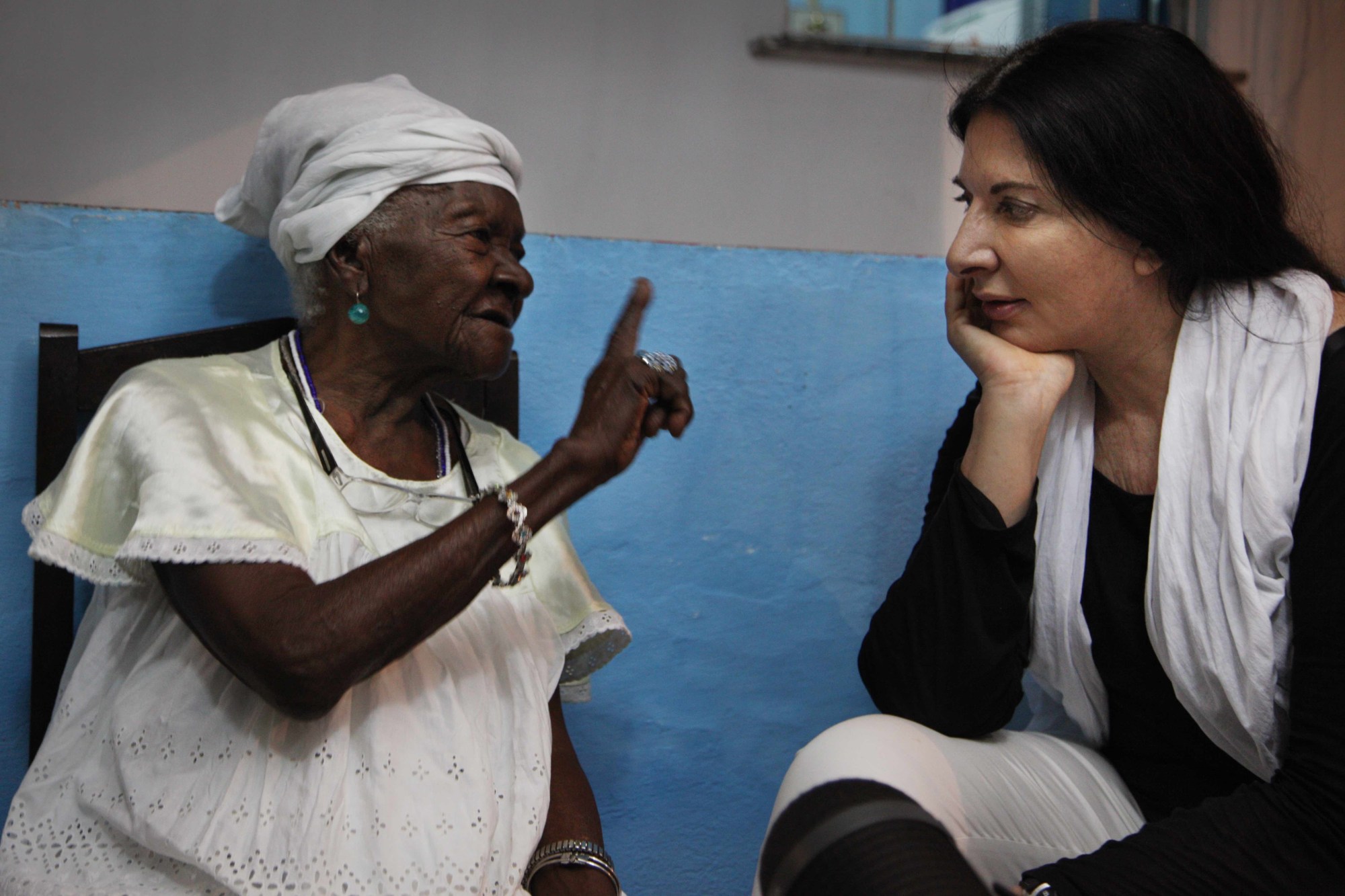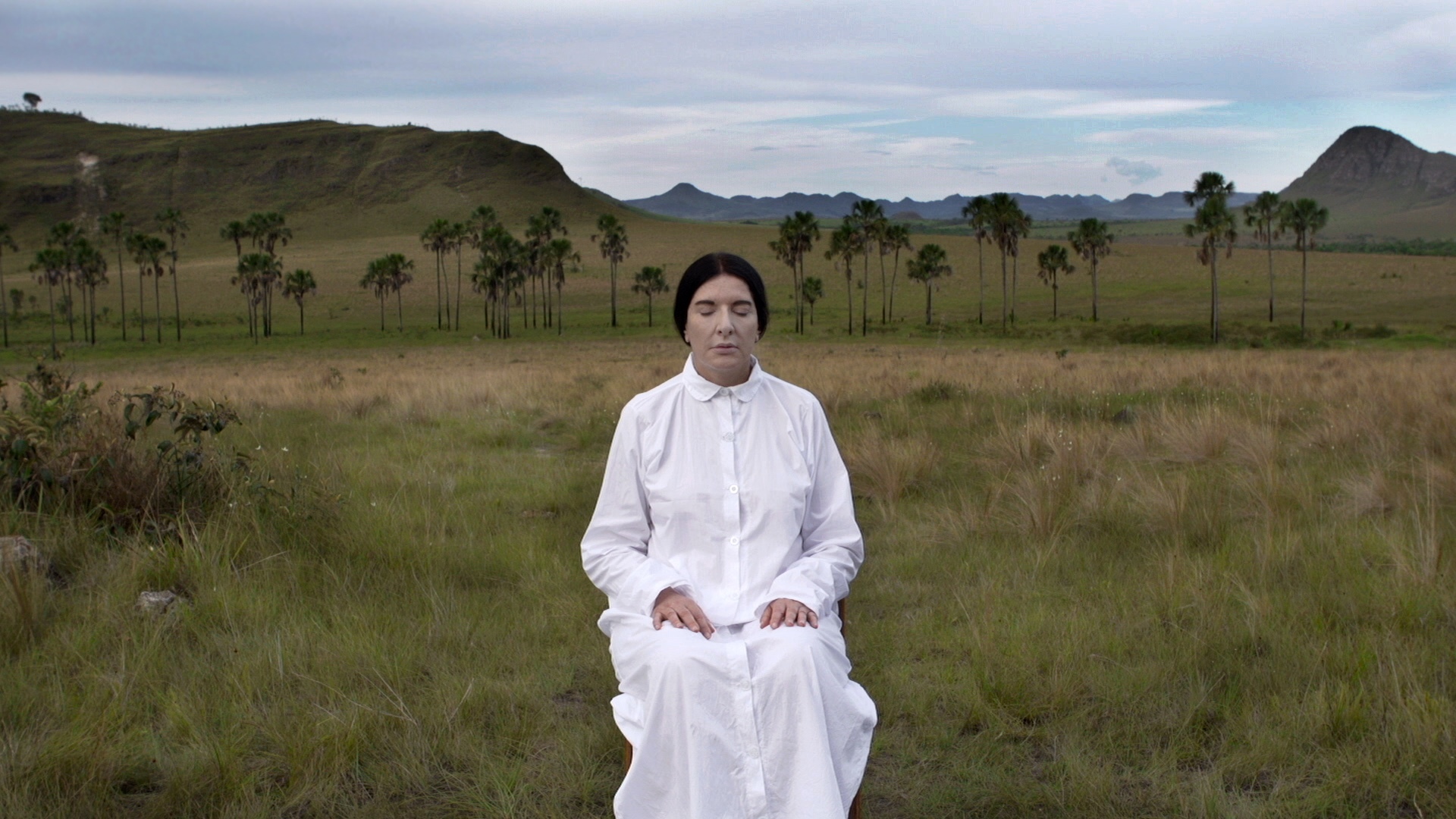On the poster for her 2012 documentary, The Artist is Present, Marina Abramović looks just as she did during her retrospective at MoMA two years prior. She wears a thick red robe, her hair is parted on the side and loosely braided, and she gazes at the camera with the same softness with which she looked at patrons during her three-month performance at the museum. But on the poster for her latest film, The Space in Between, Abramović appears more austere. She wears a buttoned-up white collared dress shirt, her dark hair is parted down the middle and pulled back, and, most significantly, her eyes are closed. It’s the perfect visual metaphor for the direction of this revealing new documentary, which follows the prolific performance artist as she looks within and expands her consciousness on a spiritual journey through Brazil.
On her emotionally charged journey, Abramović meets with a number of spiritual healers, including controversial medium João de Deus—who shoves forceps up one patient’s nose and cuts an incision into another’s eyeball—and Rudá Iandé, a shaman who uses plants and indigenous traditions to cleanse the body and mind. “I’m like a guinea pig,” she says in a conversation with i-D. “I go and try everything.” Everything includes ayahuasca, a powerful hallucinogen that makes her moan in pain and writhe naked on the ground. “It was like somebody put a bomb in my body,” she narrates in the film. “I just shit, vomit and piss all at once.”
Though the 86-minute documentary might feel, at first, like a departure from her work as a performance artist, it is actually a continuation. Abramović approaches her spiritual journey with the same intensity that she employed in The Artist is Present, and the purpose is also parallel: She is exploring the limits of the body and the possibilities of the mind. “Everything, for me, is about being curious and about seeing, and never thinking inside the box,” she explains of the documentary, which premieres on Vimeo on December 13. “I just had my birthday of 70, and I always think, I’m in the beginning. Some people say, ‘Oh my god, this is the end of the journey.’ I never see it that way. I always say, I don’t know anything, and I have to see the world through the eyes of the child.”
I watched the documentary yesterday, and I thought it was really brave to make a film on your emotional and personal issues. And it was so interesting because, in your work and in your other documentary, even though you expressed some nervousness, you do seem so confident and stoic. So why did you want to share this unsure side of yourself with the public? Why not keep your spiritual journey private?
I’ve lived my life on the stage, so privacy is a luxury I don’t have. I see this as a great learning process, and I can be inspirational for other people.
Was there something that motivated you to go on this journey now?
Well, I’ve done loads of spiritual journeys before this one—only I didn’t film them. I stayed with the aborigines in the central Siberian desert for five years; I went to so many retreats in the jungle with the Tibetan monks. But it was something I actually never recorded, except for in my diaries. And now, I think it was the time that I wanted to make this more visible. It took four years of research to make visible this personal journey, and there were also many wars and broken hearts. It was really important to show the public that out of all of this, you can actually make it work. You can go very down and to very dark spaces and still find the light.

Why did you choose Brazil for this spiritual journey?
I went to Brazil for the first time in 1989, looking for crystals, looking for minerals. And then I was somehow always going back to Brazil. I’ve been busy with Tibetan Buddhism for more than 25 years, and so to me, it was interesting to see different ways of how spirituality worked. I just wanted to see another method, you know. Now I’m interested in the shamans in Siberia, and I’m interested in the astronauts and how we are going to start life on Mars. I mean I’ve always had different interests. I’m just shifting as I go with the spirits.
Was there an experience in Brazil that most resonated with you? Or one that you found was the most healing?
It’s not just one per se. I’m like a guinea pig. I go and try everything. But one of the most memorable for me was the ayahuasca experience, which didn’t resonate with me. Taking that substance didn’t really work for me. It just became kind of a nightmare.
Do you regret taking ayahuasca?
I don’t know. So for some people, it works, for me it doesn’t. It’s interesting because so many people right now think this is the future. They think they can concoct it in different ways. But you also have to know that the same thing happened with LSD at the end of the 60s, when everybody was taking this and thinking it was helping. But for me, it really works when you make your own effort and you don’t take anything. Because when you don’t take anything, you have an experience that’s real. And that experience is so much more relevant to me. But I think the journey was important because I just try all these things to find out what works, to learn things. I need to learn. I’m always in a learning process.
Right. I don’t think every spiritual journey or ritual has to be successful. Like with the ayahuasca, it can be a kind of failure, and maybe you can learn more about yourself than you would have if it was a good experience…
Absolutely, it’s true. Everything, for me, is about being curious and about seeing, and never thinking inside a box. I just had my birthday of 70 and I always think, I’m in the beginning. Some people say, “Oh my god, this is the end of the journey.” I never see it that way. I always say I don’t know anything, and I have to see the world through the eyes of the child. But also, it’s very important to surprise yourself. If you cannot surprise yourself, you cannot surprise anybody else.

In the film, you talked about how when you’re doing a spiritual ritual, the moment you start to think about it, the experience no longer exists. I wonder if it’s the same with performance art—do you have to stop thinking when you’re doing it in order to really experience it?This is a really good question. It’s absolutely like this. If you’re waiting for the experience you’re anxious. This is exactly what you do—you actually block the experience. You block things happening to you. You have to be open to destiny. You have to be open without any expectations at all. You know when you say, I’m waiting for someone to fall in love with. This person will never come to your life. You don’t need to look for miracles—they are everywhere. You just need to open yourself to the energy around you, and things will happen.
The most important thing is to not give up. Don’t give up, ever. In my book, I’m talking about love, I’m talking about art, I’m talking about life itself. This is my experience I went through—it was not easy, but it was worth it. I wrote this book to be inspirational, I hope, for anybody who didn’t have an easy life. To see that everything is possible. You know, the book is called Walk Through the Walls because people, when they see a wall, most of them will stop. I break them. You don’t have to break them, but just go through them. There’s always another wall, it’s never-ending I think.
The film premieres on Vimeo on December 13, and screens at the Museum of Moving Image on the same day.

Credits
Text Zio Baritaux
Photography courtesy Vimeo/Marina Abramović
